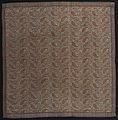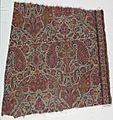Paisley (design) facts for kids
The Paisley pattern is a cool and curvy design that looks a bit like a twisted teardrop or a fancy comma. It's often shaped like a feather or a large, curved leaf. This unique pattern first came from ancient Persia and India. It became super popular around the world, especially in the town of Paisley, Scotland. That's how it got its name! You can see the Paisley pattern on many things today, like clothes, scarves, and even home decorations.
Contents
What is the Paisley Pattern?
The Paisley pattern is famous for its special shape. It looks like a curved, pointed oval, sometimes with a little swirl inside. People often describe it as a "pine cone" or "mango" shape. This design is very detailed and often has many smaller patterns inside the main shape. It can be found in many colors and sizes.
A Pattern with Ancient Roots
The history of the Paisley pattern goes back thousands of years. Its true origins are in ancient Persia, which is now Iran. In Persia, this shape was called "boteh" or "buta." It often represented a cypress tree, which was a symbol of life and eternity. The pattern was also linked to a flame or a teardrop.
From Persia to India: The Original Design
From Persia, the pattern traveled to India. It became very important in the Kashmir region of India. Here, skilled weavers used the boteh design to create beautiful shawls. These shawls were made from very fine wool, often from goats. They were known for their warmth and amazing designs. The Indian versions of the pattern often looked like a mango or a cashew nut.
How Paisley Traveled the World
In the 17th and 18th centuries, European traders and travelers discovered these stunning Kashmir shawls. They brought them back to Europe, where they quickly became very fashionable. Wealthy people, especially women, loved to wear these shawls. They were a sign of luxury and good taste.
The Rise of Kashmir Shawls
The original Kashmir shawls were very expensive. This was because they were handmade and took a long time to weave. They were also made from rare, soft wool. As more people wanted them, European factories started to make their own versions. They wanted to create similar beautiful patterns at a lower cost.
Paisley's Scottish Connection
One of the main places where these copies were made was in the town of Paisley, Scotland. Weavers in Paisley were very skilled. They developed new ways to make the complex patterns using machines. This made the shawls more affordable for many people.
Weaving History in Scotland
By the 19th century, the town of Paisley became famous for its textile factories. They produced millions of shawls with the distinctive curved pattern. Because so many of these shawls came from Paisley, the pattern itself became known as "Paisley." This is how the Scottish town gave its name to a design that started far away in Asia.
Paisley in Modern Times
The popularity of the Paisley pattern has continued through the years. It had a big comeback in the 1960s and 1970s. During this time, it was often seen on clothing worn by rock stars and people in the hippie movement. It became a symbol of freedom and artistic expression.
Today, the Paisley pattern is still widely used. You can find it on all sorts of items. These include ties, scarves, dresses, shirts, and even home furnishings like curtains and pillows. It remains a timeless and beloved design around the world.
Images for kids
-
Shawl made in Paisley, Scotland, in imitation of Kashmir shawls, c. 1830
-
A red bandana with a paisley pattern
See also
 In Spanish: Cachemira (diseño) para niños
In Spanish: Cachemira (diseño) para niños







